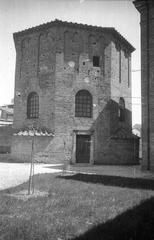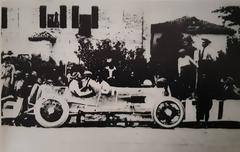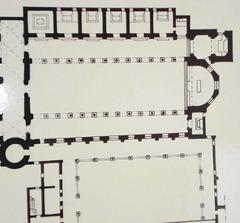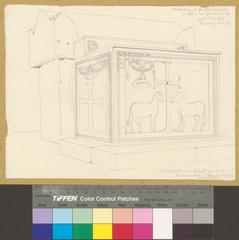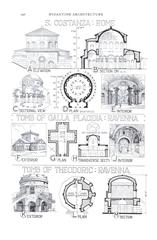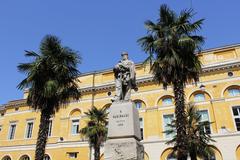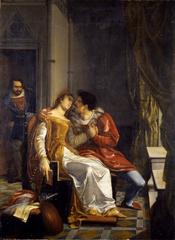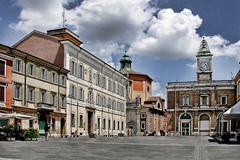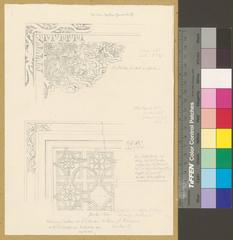Monument to Pier Paolo D’Attorre: Visiting Hours, Tickets, and Ravenna Historical Sites Guide
Date: 14/06/2025
Introduction
Located in the heart of Ravenna, Italy, the Monument to Pier Paolo D’Attorre is a powerful testament to the city’s dedication to cultural memory, civic identity, and artistic tradition. Erected to honor Pier Paolo D’Attorre (1951–1997)—a renowned historian, academic, and former mayor—the monument seamlessly integrates contemporary mosaic artistry with Ravenna’s centuries-old reputation as a center of mosaic craftsmanship. Positioned within easy reach of major landmarks such as the Basilica di San Francesco, Dante’s Tomb, and Porta Adriana, the monument invites reflection on both the city’s ancient heritage and its ongoing cultural evolution.
Master mosaicist Luciana Notturni and local artisans crafted this life-sized mosaic bench, featuring symbolic elements like a folded overcoat and a book. These details evoke D’Attorre’s intellectual legacy and the city’s enduring artistic traditions. The monument is freely accessible 24/7, wheelchair-friendly, and conveniently situated near public transportation, making it an essential stop for all visitors to Ravenna.
This comprehensive guide provides detailed insights into the monument’s history, artistic significance, visitor information (including hours and accessibility), and tips for integrating your visit with Ravenna’s other renowned sites (Official Ravenna Tourism Website; turismo.ra.it; ravennacittadelmosaico.it; TukTuk Travel Mag).
Table of Contents
- Discovering the Monument
- Who Was Pier Paolo D’Attorre?
- Visiting Hours & Tickets
- How to Reach the Monument
- Guided Tours & Special Events
- Artistic Design, Symbolism & Materials
- Mosaic Technique & Color Palette
- Urban Integration & Spatial Context
- Visitor Information & Accessibility
- Photographic Highlights & Nearby Attractions
- Practical Tips for Visitors
- Frequently Asked Questions
- Conclusion & Visitor Tips
- References
Discovering the Monument
The Monument to Pier Paolo D’Attorre is located at strategic gateways to Ravenna’s historic center, notably Piazzetta Gandhi and the Giardini Pubblici. Its approachable setting among pedestrian pathways and vibrant green spaces makes it both a contemplative landmark and an integral part of daily city life.
Who Was Pier Paolo D’Attorre?
Pier Paolo D’Attorre was a distinguished historian and academic, born in Reggio Emilia in 1951. He served as Mayor of Ravenna from 1993 until his untimely death in 1997 and was a committed advocate for the city’s UNESCO-listed mosaics and cultural preservation. His research and public service emphasized civic engagement, the value of historical memory, and the advancement of educational opportunities. The monument stands as a permanent reminder of his contributions to Ravenna’s civic and cultural vitality.
Visiting Hours & Tickets
- Location: Piazzetta Gandhi, Giardini Pubblici, near Porta Adriana
- Hours: Open 24 hours a day, year-round (park access typically from 7:00 AM to dusk)
- Tickets: Admission is free; no tickets required
- Accessibility: Fully wheelchair-accessible with paved paths and seating
Being outdoors and centrally positioned, the monument can be visited at any time without reservation. For information on guided tours and commemorative events, consult the local tourist office or Official Ravenna Tourism Website.
How to Reach the Monument
- On Foot: The monument is a short walk from major sites like Basilica di San Vitale and Piazza del Popolo.
- By Public Transport: Bus routes serve the city center with stops near Viale Santi Baldini and Via Cavour.
- By Car: Parking is available outside the Limited Traffic Zone (ZTL); the site is best accessed on foot from these lots.
- From the Train Station: Approximately a 15-minute walk (Our Escape Clause).
Interactive maps and travel tips are available on Ravenna Experience and Turismo Ravenna.
Guided Tours & Special Events
The monument is sometimes featured in specialized guided walks focusing on modern Ravenna alongside its ancient treasures. Annual events, such as the “Premio di studio Pier Paolo D’Attorre” and civic commemorations, are held at the site, often accompanied by lectures and cultural programs.
Contact the Ravenna Tourist Office for current schedules and tour options (Tours Italy).
Artistic Design, Symbolism & Materials
Design and Materials
Conceived by sculptor Matthias Biehler and completed under mosaicist Luciana Notturni’s supervision, the monument features a life-sized bench covered in vibrant mosaic tesserae. Resting on the bench are a folded overcoat and a book, both rendered in intricate mosaic, signifying a moment of pause and intellectual pursuit (ravennacittadelmosaico.it).
This artwork fuses the “ready-made” aesthetic with Ravenna’s iconic mosaic tradition, involving students from local mosaic schools in its creation.
Symbolic Elements
- The Bench: Represents memory, presence, and the social fabric of public space.
- The Overcoat: Suggests both personal absence and enduring community impact.
- The Book: Symbolizes knowledge and features a flowering motif inspired by the mosaics of Sant’Apollinare in Classe, evoking renewal and hope.
Mosaic Technique and Color Palette
Thousands of hand-cut tesserae in deep greens, reds, whites, and blues mirror the hues of Ravenna’s historic mosaics. The artistry is visible in the subtle gradients and lifelike textures, linking the monument to the city’s Byzantine heritage (nomads-travel-guide.com).
Urban Integration & Spatial Context
Strategically placed at the entrance to the historic center, the monument welcomes visitors and locals alike. Its setting in Piazzetta Gandhi and the Giardini Pubblici fosters reflection and connection, while its proximity to major sites encourages seamless exploration of Ravenna’s past and present (turismo.ra.it).
Visitor Information & Accessibility
- Opening Hours: 7:00 AM to dusk for Giardini Pubblici; monument available 24/7 in public spaces
- Admission: Free
- Accessibility: Wheelchair-accessible paths, benches, and shaded areas
- Facilities: Nearby restrooms and cafés; information at the Ravenna Tourist Office
Photographic Highlights & Nearby Attractions
The monument’s mosaic surfaces are especially striking during golden hour. Recommended photo spots capture the monument with the historic city as a backdrop.
Nearby Attractions:
- Basilica di San Vitale: Famous for 6th-century mosaics (Savoring Italy)
- Mausoleum of Galla Placidia: Adjacent to San Vitale, a UNESCO gem
- Dante’s Tomb: Resting place of Dante Alighieri, near Basilica di San Francesco
- National Museum of Ravenna: Roman and Byzantine collections
Practical Tips for Visitors
- Dress for comfort and bring water, especially in summer.
- Photography is welcome; be mindful of other visitors.
- Check event calendars for concerts or exhibitions in the park (Turismo Ravenna).
- Plan a picnic or enjoy local cafés nearby.
Frequently Asked Questions (FAQ)
Q: What are the visiting hours for the monument?
A: The monument is accessible during Giardini Pubblici’s park hours (typically 7:00 AM–dusk); Piazzetta Gandhi area is open 24/7.
Q: Is there an admission fee or need for tickets?
A: No, entry is free.
Q: Is the monument wheelchair-accessible?
A: Yes, paved and level paths make the site fully accessible.
Q: Are guided tours available?
A: Specialized tours including this site can be arranged via the tourist office.
Q: When is the best time to visit?
A: Spring and early autumn offer pleasant weather and fewer crowds; early morning or late afternoon provides ideal light for photos.
Conclusion & Visitor Tips
The Monument to Pier Paolo D’Attorre is much more than a modern sculpture—it is a living symbol of Ravenna’s enduring civic values, artistic heritage, and spirit of community. Its evocative mosaic design, rich symbolism, and accessible location make it a must-visit for those interested in the city’s layered history. Enhance your visit by exploring the surrounding UNESCO sites, participating in guided tours, and taking advantage of interactive resources like the Audiala app.
For a deeper experience, combine your visit with Ravenna’s famed mosaics and cultural events, and stay connected through official tourism channels for updates and travel tips (Ravenna Experience; Turismo Ravenna; Wikimedia Commons).
References and Further Reading
- Official Ravenna Tourism Website
- Turismo Ravenna – Monument to Pier Paolo D’Attorre
- Understanding Italy – Ravenna
- TukTuk Travel Mag – What to Do and What to See in Ravenna, Italy
- Wikimedia Commons – Monumento a Pier Paolo d’Attorre (Ravenna)
- Our Escape Clause – Ravenna Mosaics
- Savoring Italy – Ravenna, Italy
- Tours Italy – Tourist Offices
- Nomads Travel Guide – Self-Guided Walking Tour of Ravenna
- The Travel Folk – Things to Do in Ravenna
- PlanetWare – Ravenna Tourist Attractions
- The Geographical Cure – One Day in Ravenna Itinerary
